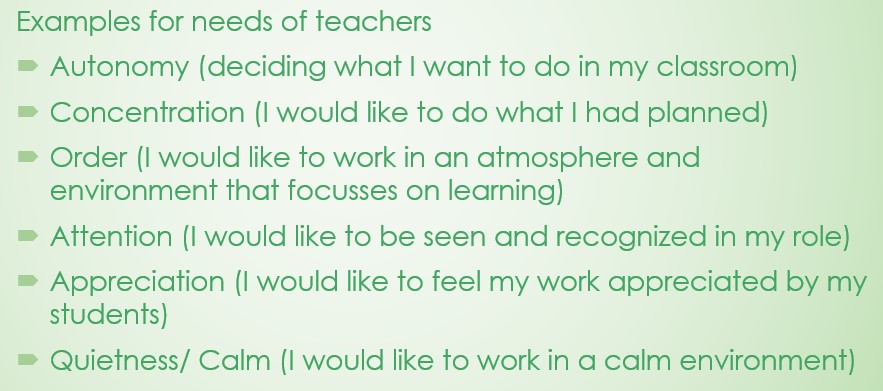Classroom Management Basics (Part 2)
This is the second part of our classroom management post. Please find part 1 here. Here we discuss some basic “cooking” strategies in your classroom and the unmet needs students may have, that trigger certain behaviors.
A cooking triangle
You
In your class you are in charge. You are the facilitator of the learning – both academic and social learning. In order to make it work, you need to be open to the needs of the students; ready and willing to connect. You need to allow a personal connection, even allowing yourself to be vulnerable by admitting failure and things you do not know. In this way students perceive you as being authentic and not just a randomly allocated teacher in an impersonal system.
Also make sure that you constantly reflect on yourself – on knowing yourself and your own needs. Be clear with yourself about the needs you want to prioritize in your class.
Your students
Have a very close look into the needs of your students: Who are they? Where do they come from? Do they have issues at home? Is there anything that keeps them from learning or might lead to disruptive behavior?
Connect to what is important to them in their life. Ensure that topics in your class are relevant to their daily life outside of school.
Teach them how to express their own needs and feelings. This will help them to identify their own triggers and to avoid them. They will be able to adjust themselves more easily in situations. A simple question like “how did you feel when…?” can make a huge difference in their personal growth.

The environment
Make sure you agree with your students on rules for your classroom. These rules need to be individually agreed and, as in any agreement, they should apply to everyone – including you as the teacher. Display the rules visibly in your lesson and keep coming back to them constantly as a reminder.
If you or your students feel there are adjustments needed to these rules in order to accommodate learning in a better way, create a new agreement.
Make sure you organize your environment. Be on time. Be prepared. Adjust the seating arrangements according to the best possible way of accommodating learning.
Be aware of the school environment. Exchange with teachers in neighboring classrooms and teachers who teach the same class in other subjects. Be aware of the needs of other classes when you plan activities.
What does that mean for your classroom management?
Disruptive behavior is a clear sign that needs are not being met.
Making sure that a lesson works, and that learning is facilitated in a way that ensures progress for all students is about meeting the needs of all of the students (which we discussed in Part One). However, as a teacher, you also need to find a balance between your own needs and those of the students..

Once you are clear about these two, you can start finding strategies that will meet both of your needs.
Strategies are doable actions. It is very crucial to become clear about which strategy can lead to actually meeting a need. In order to make sure that the need is met you need to ask for feedback (directly from the students, as well as through your own reflections).
Prioritize the learning needs over the lesson planning. There is no point in teaching a great lesson if students are not in the right “thinking space” to follow and connect.
Cooking gets better with experience:
Try new strategies, but do not get frustrated if it does not quite work the first time. Give it time. Give yourself time. Give the students time to adjust. Your experiences and reflections will help you to build a set of tools that you can then apply more easily next time.
Be brave in trying new things and mixing recipes with traditional dishes:
Check out new ways to accommodate learning. That does not mean forgetting about traditional ways, but rather to enhance them. Many new tools make learning more interesting, engaging and thus motivating for the students. They can also lead to reduced preparation and marking time. Just be open and try.
Thrive on feedback:
All cooking ends with tasting. Sure enough, you can only get better when inviting and receiving feedback. Make it a point in your class to have students give you feedback on your teaching, single activities or on the entire lesson.
Cook with friends:
You are not alone. Sometimes as a teacher it certainly feels like you are. Just remind yourself that there are people around you that you can involve in your classroom and in your teaching. Do not hesitate to ask for support when needed.
Find projects that you can co-teach. For example, send students to the science teacher to interview about a scientific text you cover in English. Have the music teacher come and play an instrument in your class when you cover sound waves in physics. Involve the art teacher when you speak about an artist in Arabic.
Try to find connections between different grade levels. Have students of older classes do a reading project with a younger class. Bring in younger students to have older students roleplay something with them for a French class…
Be creative and open your classroom door to fellow teachers and students from other classes.

Learn from media, books, training:
Even the most accomplished cooks love reading the cookbooks of other great cooks. Try to stay connected to the education world. There are many useful resources out there that might help you to find the right strategy for your specific need. You can only be a good teacher if you are a good learner at the same time. Try to read a lot and choose professional literature outside of your comfort zone. Take part in trainings actively. Ask questions. Challenge the trainer.
But remember: Do not just copy and paste.
Using this mindset as a base for your classroom management “cooking” the outcome will be “delicious” for everyone.
Enjoy!

